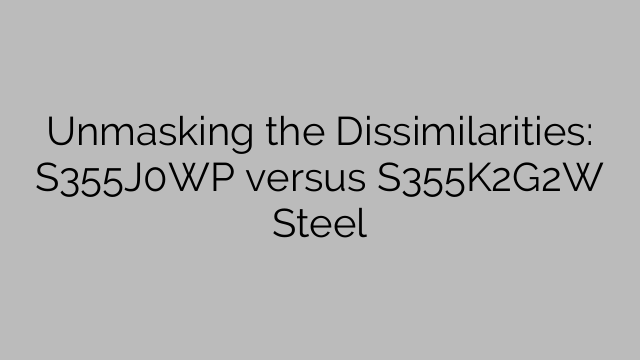Unmasking the Dissimilarities: S355J0WP versus S355K2G2W Steel
When it comes to selecting the right steel for outdoor structures, one needs to consider various factors such as corrosion resistance, strength, and reliability. Two popular choices for such applications are S355J0WP and S355K2G2W steel. Although they may seem similar at first glance, they exhibit significant differences that impact their performance and suitability for specific environments.
Starting with S355J0WP steel, it is a weathering steel grade that provides excellent resistance against atmospheric corrosion. With its unique alloy composition, which includes copper, chromium, nickel, and phosphorus, it forms a dense protective oxide layer on the surface when exposed to the elements. This layer acts as a barrier, preventing further corrosion and thus making it a popular choice for outdoor structures and architectural applications.
S355J0WP steel offers good mechanical properties, including a minimum yield strength of 355MPa and a minimum tensile strength of 510-680MPa. It is commonly used in bridge, tower, and pole construction, as well as facades, roof panels, and other architectural elements exposed to harsh climatic conditions. However, it should be noted that this steel is not suitable for use in marine environments, as the chloride content can significantly reduce its corrosion resistance.
On the other hand, S355K2G2W steel belongs to the group of structural steels with improved atmospheric corrosion resistance. It shares similarities with S355J0WP, but its alloy composition is slightly different, containing higher amounts of chromium, nickel, and phosphorus. This steel grade offers enhanced resistance against corrosive elements, such as sulfur dioxide, hydrogen sulfide, and various acids, making it ideal for applications in polluted and industrial environments.
S355K2G2W steel exhibits excellent weldability and machinability, allowing for easy fabrication and forming. It has a minimum yield strength of 345MPa and a minimum tensile strength of 510-680MPa, making it suitable for various structural applications. Additionally, it maintains its mechanical properties even at high temperatures, providing stability and reliability in extreme conditions.
Although both S355J0WP and S355K2G2W steel grades possess significant corrosion resistance, the latter offers superior performance in polluted and industrial settings due to its elevated levels of chromium and nickel. Therefore, when selecting the appropriate steel for outdoor structures, it is crucial to consider the specific environmental conditions and the level of corrosion protection required.
In conclusion, understanding the dissimilarities between S355J0WP and S355K2G2W steel is essential for making an informed decision based on the specific application’s requirements. While S355J0WP provides excellent resistance against atmospheric corrosion, it falls short in marine environments. On the other hand, S355K2G2W offers enhanced protection against corrosive elements, making it the preferred choice for polluted and industrial environments. By evaluating the environmental factors and the desired mechanical properties, one can select the most suitable steel grade to ensure the longevity and reliability of their structures.

